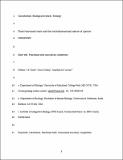Por favor, use este identificador para citar o enlazar a este item:
http://hdl.handle.net/10261/115555COMPARTIR / EXPORTAR:
 SHARE SHARE
 CORE
BASE CORE
BASE
|
|
| Visualizar otros formatos: MARC | Dublin Core | RDF | ORE | MODS | METS | DIDL | DATACITE | |

| Título: | Plant functional traits and the multidimensional nature of species coexistence |
Autor: | Kraft, Nathan J. B.; Godoy, Óscar CSIC ORCID ; Levine, J. M. | Palabras clave: | Competition Functional traits Community assembly Coexistence |
Fecha de publicación: | ene-2015 | Editor: | National Academy of Sciences (U.S.) | Citación: | PROCEEDINGS OF THE NATIONAL ACADEMY OF SCIENCES OF THE UNITED STATES OF AMERICA 112: 797- 802 (2015) | Resumen: | Understanding the processes maintaining species diversity is a central problem in ecology, with implications for the conservation and management of ecosystems. Although biologists often assume that trait differences between competitors promote diversity, empirical evidence connecting functional traits to the niche differences that stabilize species coexistence is rare. Obtaining such evidence is critical because traits also underlie the average fitness differences driving competitive exclusion, and this complicates efforts to infer community dynamics from phenotypic patterns. We coupled fieldparameterized mathematical models of competition between 102 pairs of annual plants with detailed sampling of leaf, seed, root, and whole-plant functional traits to relate phenotypic differences to stabilizing niche and average fitness differences. Single functional traits were often well correlated with average fitness differences between species, indicating that competitive dominance was associated with late phenology, deep rooting, and several other traits. In contrast, single functional traits were poorly correlated with the stabilizing niche differences that promote coexistence. Niche differences could only be described by combinations of traits, corresponding to differentiation between species in multiple ecological dimensions. In addition, several traits were associated with both fitness differences and stabilizing niche differences. These complex relationships between phenotypic differences and the dynamics of competing species argue against the simple use of single functional traits to infer community assembly processes but lay the groundwork for a theoretically justified trait-based community ecology. | Descripción: | 6 páginas, 3 figuras.-- 3 tablas.-- 41 referencias.-- This article contains supporting information online at http://www.pnas.org/lookup/suppl/doi:10.1073/pnas.1413650112/-/DCSupplemental | Versión del editor: | http://dx.doi.org/10.1073/pnas.1413650112 | URI: | http://hdl.handle.net/10261/115555 | DOI: | 10.1073/pnas.1413650112 | Identificadores: | doi: 10.1073/pnas.1413650112 issn: 1091-6490 |
| Aparece en las colecciones: | (IRNAS) Artículos |
Ficheros en este ítem:
| Fichero | Descripción | Tamaño | Formato | |
|---|---|---|---|---|
| Kraft-2015-PNAS.pdf | 1,85 MB | Adobe PDF |  Visualizar/Abrir |
CORE Recommender
PubMed Central
Citations
128
checked on 10-abr-2024
SCOPUSTM
Citations
615
checked on 16-abr-2024
WEB OF SCIENCETM
Citations
575
checked on 26-feb-2024
Page view(s)
326
checked on 17-abr-2024
Download(s)
3
checked on 17-abr-2024
Google ScholarTM
Check
Altmetric
Altmetric
Artículos relacionados:
NOTA: Los ítems de Digital.CSIC están protegidos por copyright, con todos los derechos reservados, a menos que se indique lo contrario.
